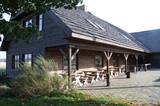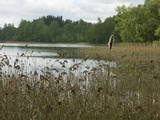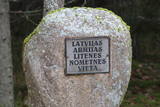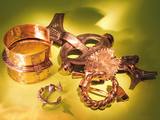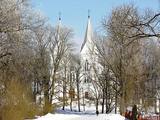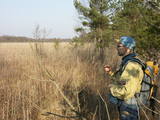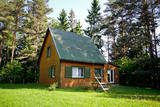| Нo | Название | Описание |
|---|---|---|
|
Taka izveidota Limbažu Lielezera ZA galā, tā ir 3.6 km gara vienā virzienā. Ezeru ziemeļu galā izbūvēts putnu novērošanas tornis. Izbūvēts bērnu rotaļu laukums, labiekārtotas atpūtas vietas, izveidota laivu piestātne. Pāri Donaviņai izveidots gājēju tiltiņš uz pontoniem. |
||
|
Расположена в нескольких километров к северу от Юркалне. Разместилась в срубном здании с латышским интерьером. Готовит кондитерские изделия и сотрудничает с надомниками. Латышская кухня: Суп из крапивы с гусиным яйцом, уха из рыбы Балтийского моря, серый горох с копченым окороком, картофельные блины с лососем, селедка с творогом, домашние котлеты, тушеные свиные ребрышки, праздничное жаркое с осенними ягодами, говядина в соусе из лисичек, котлеты из мяса кабана, жареное филе трески или судака, слойка из ржаного хлеба, березовый сок, напиток из красной смородины. Особое блюдо: Сделанные в «Закю крогсе» вареные пельмени с мясом. |
||
|
A diverse stand of forest that is bisected by the Vidzeme highway and the Rīga-Lugaži railroad line. This is a place where the largest endangered bird in the world – the European roller – can be found. Between one-quarter and one-fifth of the Latvian population of the crow is found here. This, too, is one of the last nesting places for the green woodpecker.
|
||
|
"Mākoņmalas" is located in the middle of the forest, in silence. A magical place where you can enjoy SPA procedures and sauna rituals, gain knowledge in magical and non-traditional practices, as well as be alone with nature, improve health, enjoy a "short vacation for the hurried and busy". In "Cloud Edges" you will receive a restart for both body and soul. After the procedures, it is possible to enjoy a deep night's sleep in our home and taste the early breakfast on the terrace, watching the morning rituals of wild animals and the beauty of nature. You can enjoy the morning with a stick or a regular morning walk through the forest to meet deer and other forest dwellers. |
||
|
Кондитерская - кафе в Саулкрасты, недалеко от железнодорожной станции Саулкрасты. Предлагают выпускаемые изделия кондитерского магазина - пирожки, сдобные булочки, пирожные, кексы и блюда на все случаи жизни. В Саулкрасты на ул. Райня, д. 7, находится второе кафе. Латышская кухня: Холодный суп, рассол, квашеная капуста, домашние котлеты, серый горох с салом. Особое блюдо: Пиццы, приготовленные в дровяной печи. |
||
|
Vairākas salas Zvirgzdenes ezerā, uz kurām saglabājušies platlapju (ozolu, liepu) meži ar bagātīgu zemsedzes floru. Salas var redzēt no ceļiem, kas piekļaujas ezera ziemeļu un austrumu krastam. |
||
|
Наивысшая точка в южной части Даугавпилса – в окрестностях улицы 18-го Ноября, где на сравнительно небольшой территории в радиусе ~ 0,3 км находятся церкви четырех конфессий – храм Даугавпилсской Новостроенской старообрядческой общины (1908 – 1928), Даугавпилсский православный кафедральный собор святых благоверных князей Бориса и Глеба (1905), Римско-католическая церковь Пресвятой Богородицы (1905) и Кафедральный собор Мартина Лютера (1893). |
||
|
Atpūtas centrā tiek piedāvāta iespēja atpūsties brīvā dabā kolektīviem vai individuāliem apmeklētājiem. Iespējams izmēģināt dažādus metamos ieročus (nažus, cirvjus u.c.), kā arī šaušanu ar dažāda veida lokiem, arbaletiem, pneimatiku u.c. |
||
|
Название Литене связано с одной из трагических страниц истории Латвии. В 20 - 30 года XX века недалеко от Литене находился летний лагерь латвийской армии, где летом 1941 года против латышских офицеров был направлен террор коммунистического режима: почти полтысячи офицеров латвийской армии были высланы в Норильск, Сибирь, часть была расстреляна и тайно похоронена в ближайшем лесу. В конце лета 1941 г. армия гитлеровской Германии расстреляла здесь около 300 гражданских жителей, главным образом евреев. В наши дни в честь памяти погибших увековечены места памяти. |
||
|
Atrodas 2,5 km no Bārtas centra, Bārtas upes labajā krastā. Mūsdienīgais dievnams tapis 2002. gadā (arhitekte: A. Siliņa). |
||
|
Музей Малтской 2-й средней школы. Галерея украшений
древних латгальцев 6 – 13 веков.
Время работы: 9.00 – 16.00, Сб.,Воскр.: выходные |
||
|
Биковский (Гайгалавский) Римско-католический костёл
Пресвятого Сердца Иисусова. Костёл радует путешествен-
ников своими белыми ярусами, готическими формами и
архитектурным дизайном. Храм внутри украшен роскошными
изображениями святых.
|
||
|
You will find the nice and quiet Kuusiku Nature Farm on the edge of the beautiful Lahemaa National Park by Lake Viitna Pikkjärv. The Kuusiku Farm offers traditional farm bread. |
||
|
Находится в помещении Hotel Jelgava. Предлагаются традиционные латышские блюда, а также блюда на другой вкус. Организуются музыкальные вечера. Латышская кухня: Стейк из выращенного в Латвии страуса. Особое блюдо: Кукурузный цыпленок со шпинатно – картофельным муссом и гриллированная на вертеле морковь. |
||
|
Das Gedenkzeichen in Ošvalki, das den lettischen Flüchtlingen (1944 – 1945) gewidmet ist, die über die Ostsee in Fischerbooten nach Schweden geflüchtet sind. |
||
|
Маршрут предусмотрен для опытных туристов, кому нравиться объединять наплюдения за природой с познанием культурной среды и истории. Это путешествие по самой впечатляющей речной долине в Балтии – древней долине Гауи. Маршрут начинается в Сигулде, которую с давних пор называют «Видземской Швейцарией». В окрестностях Сигулды открываются одни из красивейших пейзажей в Латвии. Маршрут пересекает глубокие овраги многих притоков Гауи и открывает внушительные в масштабах Балтии обнажения песчаника девонского периода. Природные тропы Лигатне – это единственное место в Латвии, где в условиях, максимально приближенных к естественной жизни в природе – в широких вольерах – можно увидеть разные виды диких животных. Поселок бумажной фабрики Лигатне – это великолепный пример индустриального наследия европейского масштаба со своеобразной средой поселка 19-го – 20-го веков. Цесисский средневековый замок – это мощная крепость средневековой Ливонии с современным центром для посетителей. Конечный пункт маршрута в Валмиере, одном из старейших городов Латвии. Информация о маршруте от Latvijas Lauku forums |
||
|
This lime swamp of grasses is in an area among dunes which floods from time to time, and it is an important location for many protected plants. The swamp is easily surveyed from the forested dunes which are on the south-eastern side of the swamp. |
||
|
The first wooden Catholic church in Dagda was built in 1705, while the church that is seen today was built in the Baroque style during the latter half of the 18th century, the work financed by a local nobleman. Important interior elements include the altar, the pulpit, the organ, a monument to the Hilsen dynasty, etc. To the North of the church is historical Dagda itself, with typical red brick buildings from the early 20th century that are known as the former homes of Jewish merchants.
|
||
|
Создает красивые работы в черной (окуренной) технике. Посетители могут присесть к гончарному кругу и поучаствовать в открытии печи. Заказ и приобретение керамических работ. Параллельно можно осмотреть декоративный сад и получить услуги флористки. |
||
|
Коттедж “Sala” и баня у озера Вертукшнес предлагает занятия и услуги, направленные на практикование здорового образа жизни. Очищение организма, лечебные курсы по снижению веса, терапия цветом или лечебное светолечение с помощью аппарата Bioptron pro 1. |
||


